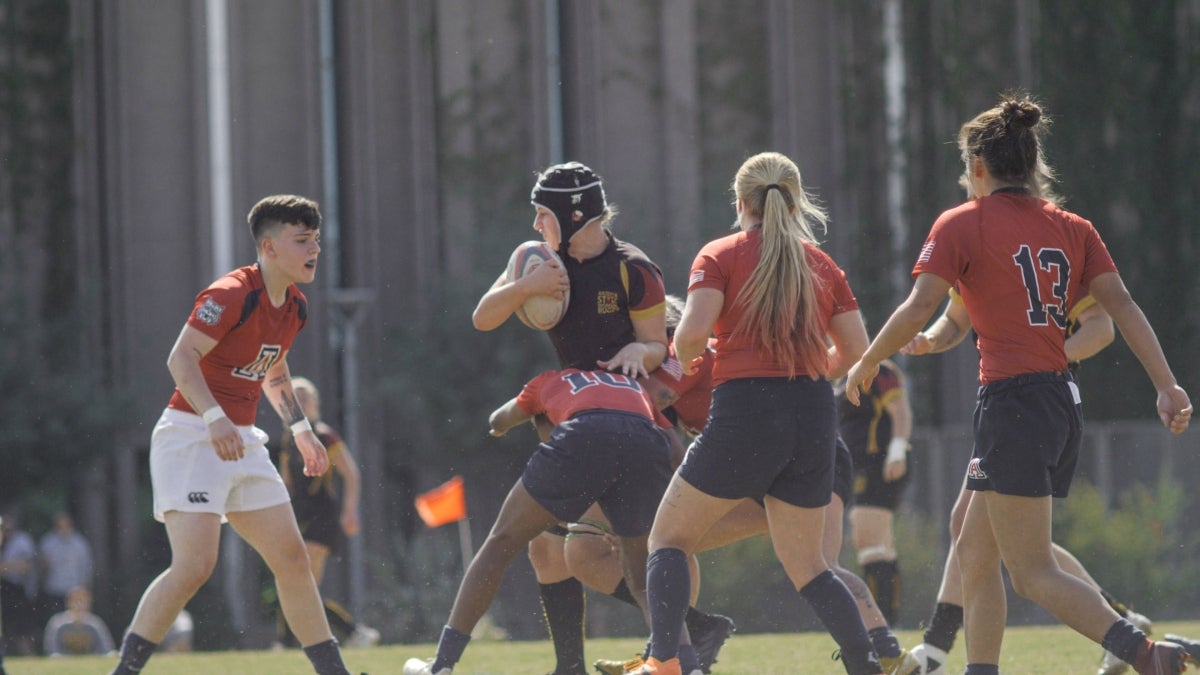Psychology student benefits from teamwork on the rugby field and in the classroom

Mimi Fina leads the charge against ASU's rival, the University of Arizona Wildcats. Photo by Robert Ewing/ASU
Mimi Fina thinks it's fun to charge into a pile of rugby players wrestling for the ball. She plays the “lock” position for the Arizona State University women’s rugby team. The primary goal of this position is to win the ball and help put the team in a position to succeed. This position is invaluable for the end result, but it is almost never recognized on the stat sheet.
The skills she uses on the rugby field — hard work, cooperation and persistence — also influence how she approaches her studies in the ASU Department of Psychology. Rugby taught Fina the importance of putting in the necessary hard work to help her team succeed.
This mentality of putting other people first contributes to Fina wanting to work with children. She recently worked as a student facilitator in ASU’s Child Study Lab and added a minor in early childhood education.
“I’ve always been interested in how things work, and ultimately helping kids is something I want to do in my career,” Fina said.
Related: Psych for Life initiative illustrates how ASU psychology degree translates into career success
Fina said the benefits of rugby extend beyond scoring points and winning matches: She feels the support of her teammates, even off the field.
“Sometimes it is hard to ask people how to do something in a class, but when you have teammates in the same major it really can propel you to be successful,” Fina said. “Being part of a team is being part of a family.”
Question: What was your “aha” moment, when you realized you wanted to study the field you majored in?
Answer: I realized during high school that I wanted to major in psychology because I really wanted to help people, and I really enjoy being able to understand people and why they make the decisions they do.
Q: What are you interested in with psychology?
A: I want to work with children. I think that they truly deserve the best this world has to offer and believe that they are the future.
Q: What’s something you learned while at ASU — in the classroom or otherwise — that surprised you or changed your perspective?
A: When I came to ASU, I learned how truly diverse this university is and have realized how many paths people have taken to end up here. I am from Tucson, so by coming to ASU I was able to meet new people with different backgrounds who come from all over the world, which has expanded my worldview.
Q: What made you interested in rugby?
A: I had wrestled in high school and loved the challenge. While I never played in high school, I had watched a game once and it really intrigued me. When I saw ASU rugby at the Passport to ASU fair, I knew I had to try it.
Q: Why did you choose ASU?
A: I am from Tucson, and coming here gave me the ability to be away from home but still close enough to see family for holidays.
Q: Which professor has taught you the most important lesson so far?
A: Dr. (Carolyn) Cavanaugh Toft and Dr. (Sarah) Lindstrom Johnson have both taught me that while studying hard is important, finding something that you love and enjoy is extremely valuable. I have loved both of their classes because they had a passion for the subject that showed through in their teaching.
Q: What’s the best piece of advice you’d give to students?
A: I would tell them to find what they love, not just a subject area but also an activity that will keep you social and get you out of the house. It's important to do things you love and to maintain a school and life balance.
Q: What is your favorite spot on campus, whether for studying, meeting friends or just thinking about life?
A: My favorite spot on campus is in the bottom of the MU. It is a central spot and is a good place to rest and get some work done between classes.
Q: If someone gave you $40 million to solve one problem on our planet, what would you tackle?
A: I would want to support communities that do not have strong mental health programs. I would help them to create programs to help people become the best and most healthy versions of themselves.
More Science and technology

New NIH-funded program will train ASU students for the future of AI-powered medicine
The medical sector is increasingly exploring the use of artificial intelligence, or AI, to make health care more affordable and…

Cosmic clues: Metal-poor regions unveil potential method for galaxy growth
For decades, astronomers have analyzed data from space and ground telescopes to learn more about galaxies in the universe.…

Indigenous geneticists build unprecedented research community at ASU
When Krystal Tsosie (Diné) was an undergraduate at Arizona State University, there were no Indigenous faculty she could look to…
